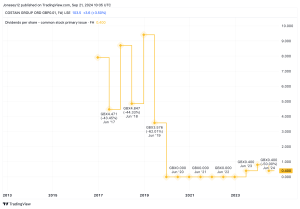The Rolls-Royce (LSE:RR.) share price has halved over the past five years.
A bribery scandal in Brazil, faults with some of its aircraft engines, and the near-destruction of the aviation industry due to the Covid-19 pandemic have all taken their toll on the company.
To adapt and survive, Rolls-Royce is seeking to become less reliant on its traditional markets. In 2022, the civil aerospace and defence sectors contributed 45% of revenue and 88% of profit.
| 2022 performance by sector | Revenue (£m) | Operating profit (£m) |
| Civil aerospace | 5,686 | 143 |
| Defence | 3,660 | 432 |
| Power systems | 3,347 | 281 |
| New market | 3 | (132) |
| Other (including corporate) | (5) | (72) |
| Totals | 12,691 | 652 |
As part of its diversification into new markets, the company plans to develop and sell small modular reactors (SMRs).
These mini nuclear power stations are expected to sell for £2bn apiece. With a capacity of 470MW, each one should generate enough electricity to power a city the size of Leeds.
With a 60-year life and a build time of four years, the company is confident that a sizeable market exists for this re-packaged technology.
I agree.
Conventional nuclear power stations may be up to 10 times larger but they have a history of running significantly over budget.
In 2016, Hinkley Point C (3,200MW) was expected to cost £18bn to build. The project is now 10 years behind schedule and will have a final price tag in excess of £30bn. The plant has the dubious honour of being the most expensive object on earth.
Rolls-Royce only has to sell seven reactors each year to beat its 2022 turnover. And there will be recurring revenue from ongoing maintenance and refurbishment contracts.
Rivals
But the company does face some competition.
GE Hitachi Nuclear Energy has recently signed an agreement with OPG Power Ventures to build a 300MW plant in Canada. Completion is expected in 2028. And the US government is backing similar projects elsewhere in North America.
Although critics acknowledge that nuclear power doesn’t produce any greenhouse gases, they do argue that the technology is dangerous. The hazardous waste also needs to be disposed of correctly and remains toxic for thousands of years.
Nuclear power may be more reliable than renewable energy but it’s more expensive.
However, there are enough governments around the world backing nuclear power to create a sizeable market.
The UK government is partnering with Rolls-Royce to deliver the first SMR. Last year, it committed £210m of taxpayers’ cash to the development programme.
I can also see significant demand coming from overseas.
France is particularly keen on nuclear energy, with over 75% of its electricity being generated by ageing plants. Ukraine, Slovakia, and Belgium also use this method to produce the majority of their electricity.
I’m therefore confident that small nuclear power stations will be a lucrative market for Rolls-Royce.
Patience
But I believe it’ll take several years before it has an impact on the company’s share price. Even then, it’s likely to be more akin to a firework than a nuclear explosion.
The first SMR is not expected to be fully operational until 2030.
And I suspect potential customers will be reluctant to place orders until they see the technology working safely and reliably.
However, in my view, successful investing is all about taking a long term view. If funds allowed, I’d be comfortable owning shares in Rolls-Royce in anticipation of its SMRs contributing the majority of future revenue and earnings.
Until then, the company’s existing markets should continue to benefit from the post-pandemic recovery.
This post was originally published on Motley Fool







